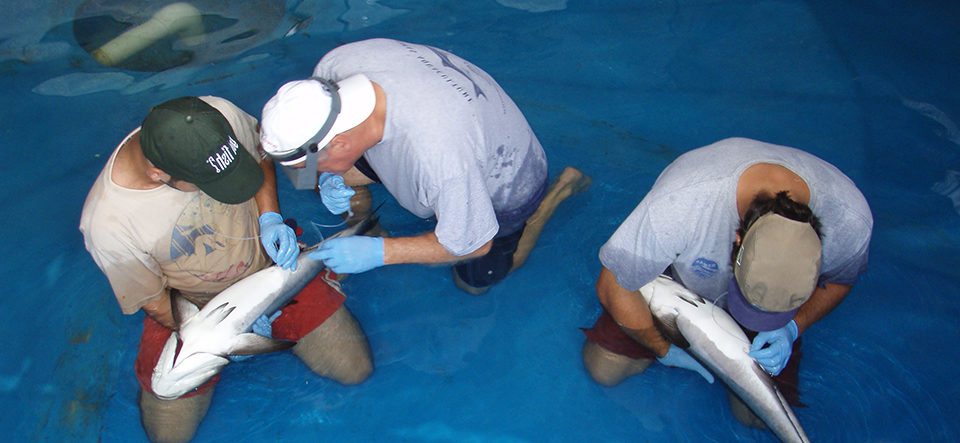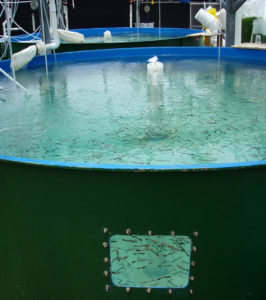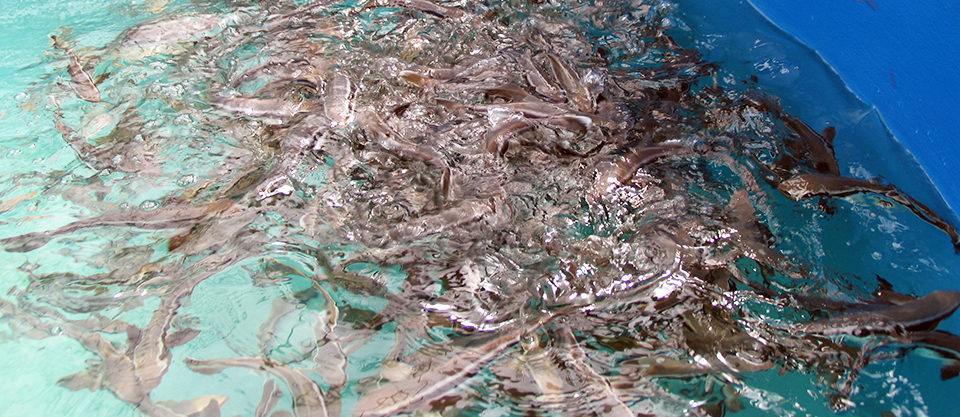About 180,000 fingerlings shipped in 2008, with 90 percent survival

During the last three years, methods for the capture, transport, acclimation, sampling, conditioned spawning, larval rearing and fingerling production of cobia, Rachycentron canadum, have been perfected at the University of Miami Experimental Hatchery (UMEH) in Miami, Florida, USA. Likewise, standard operating procedures for shipping eggs, larvae, fingerlings and broodstock were firmed up. Current shipping methods resulted in 90 percent survival for shipments made in 2008, including shipments to several U.S. states, the Caribbean and a number of Central and South American countries.
Wild and F1 broodstock cobia have been conditioned to spawn through temperature manipulation, producing viable eggs for experimental and production-level larval-rearing trials in several hatcheries. An ongoing selective-breeding program at UMEH has already yielded extraordinary results in its early stages.
In 2007, F1 selected broodstock cobia outperformed wild cobia in number of spawns as well as fertilization and hatching rates. As a consequence, in 2008, only F1 selected broodstock with outstanding performance – having naturally spawned 78 times on and off season – were kept in maturation tanks. Survival rates ranging 17.5 to 35.0 percent were achieved from egg to 1-gram shipping-size fingerlings in 2007-08 at the facilities, with peak productions greater than 20,000 fingerlings/12-cubic-meter tank. In 2007 and 2008, more than 300,000 fingerlings were produced at UMEH.
Cobia are susceptible to infestations by parasitic protozoa such as Amyloodinium ocellatum and to infections caused by deleterious bacteria such as Photobacterium and Vibrio species. Methods to prevent and control epizootic diseases at the hatchery have been successful.
Maturation and spawning
In 2008, 78 natural spawns occurred in two maturation systems at UMEH, generating over 150 million fertilized eggs. From these spawns, viable eggs and larvae were used for larval-rearing trials using probiotics and a simplified live feed regime. In addition, millions of eggs and larvae were shipped to several academic and research institutions, as well as the private sector for experimental and production trials.
Larval-rearing trials

In 2006, 2007 and 2008, larval-rearing trials were conducted with varying degrees of success. Overall, survival rates from eggs to fingerlings ranged from 3 to 35 percent. In 2006, several thousand fingerlings were shipped to Puerto Rico to stock Snapperfarm’s submerged cage and other cobia start-up operations in the U.S. and abroad. In 2007 and 2008, over 200,000 cobia fingerlings produced at UMEH were shipped to Marine Farms Belize and other private companies in the Caribbean and Latin America for grow-out.
During the last two years, firm protocols were developed for cobia larviculture at UMEH. The protocols incorporate the use of probiotics, minimize microalgae use and integrate commercially available ingredients for live feed enrichment.
In summary, fertilized eggs were stocked at 400 per liter and incubated in 1-cubic-meter cylinder-conical tanks with flow-through seawater at 500 percent daily exchange rate. Moderate aeration and pure oxygen were used to maintain dissolved-oxygen concentrations above saturation. Hatching occurred 22 to 24 hours after fertilization.
Yolk-sac larvae were stocked in four 12-cubic-meter cylinder-conical tanks at 10 larvae per liter. Beginning three days posthatch, larvae were fed Isochyrsis galbana microalgae at 5-10,000 cell/ml and enriched rotifers (Brachionus plicatilis), at 3 to 5/ml through day 9. Beginning on the seventh day, enriched Artemia franciscana nauplii were fed to larvae at 0.1 to 1/ml.
Cobia larvae were reared at water temperatures ranging 24.3-31.8 degrees-C. Water was filtered prior to entering the tanks to 10 µ using standard sand and bag filters. Daily water exchange rates in the tanks ranged from 100 to 500 percent. Between 20 and 22 days posthatch, all postlarvae were fully weaned onto dry starting diets.
The trials conducted in 2007 generated over 120,000 fingerlings in four tanks in just two months. In 2008, larval-rearing production trials resulted in the production of almost 200,000 fingerlings. These levels of production are sustaining commercial operations, indicating that cobia aquaculture can be viable in the Americas.

Shipping success
In 2007 and 2008, UMEH continued to develop and improve fingerling shipping methodologies. Excellent survival was achieved in shipping over 300,000 fingerlings to several academic, government and industry collaborators in interstate and international shipping. In April 2007, 12 broodstock cobia ranging 4-7 kg each in weight were successfully shipped by truck from the University of Miami Hatchery to the Great Bay Aquaculture hatchery in New Hampshire, USA.
In 2007, approximately 120,000 fingerlings were shipped to a variety of locations with a survival rate of 88 percent. In 2008, about 180,000 fingerlings were shipped with average survival over 90 percent.
Collaboration with industry, government
The hundreds of thousands of cobia fingerlings produced at UMEH as a “byproduct” of the larval-rearing research are being used for research trials and commercial production. For example, several thousand fingerlings were shipped to Harbor Branch Oceanographic Institution in Florida, USA, and to the Center of Marine Biotechnology in Maryland, USA, for experimental trials in nutrition and stocking densities using recirculating systems.
UMEH is currently collaborating with Rockaviar Sturgeon Farms of Homestead, Fla., on research to acclimate and raise cobia in freshwater using recirculating systems. In addition, UMEH is collaborating with the Cape Eleuthera Institute in South Eleuthera, the Bahamas, on a growout trial using a submerged cage system stocked with fingerlings produced at the institute to test the performance of a new line of feeds specifically formulated for tropical marine fish by Nicovita in Peru.
UMEH continues to collaborate with the industry and institutions for the development of marine fish culture in the United States. Through the National Marine Aquaculture Initiative (NMAI), the National Oceanic and Atmospheric Administration (NOAA) has provided partial funding for the research projects conducted at UMEH. The Aquaculture Program at the University of Miami has matched every dollar granted by government-sponsored projects through memorandums of understanding and by transferring and selling the eggs, larvae, fingerlings and technology generated by the research to the government and private sectors. And in addition to operating the hatchery since 2006, graduate students including Bruno Sardenberg, Aaron Welch, Ronald Hoenig and John Stieglitz have conducted thesis research in work partially funded by the NOAA-NMAI grant.
The vision of the Aquaculture Program at the University of Miami Rosenstiel School of Marine and Atmospheric Science is that research and academic institutions must engage in collaboration with the government and the private sector in order to take science and technology to the next level by achieving commercial and economic feasibility. The program has been successful in its endeavors.
(Editor’s Note: This article was originally published in the January/February 2009 print edition of the Global Aquaculture Advocate.)
Now that you've finished reading the article ...
… we hope you’ll consider supporting our mission to document the evolution of the global aquaculture industry and share our vast network of contributors’ expansive knowledge every week.
By becoming a Global Seafood Alliance member, you’re ensuring that all of the pre-competitive work we do through member benefits, resources and events can continue. Individual membership costs just $50 a year. GSA individual and corporate members receive complimentary access to a series of GOAL virtual events beginning in April. Join now.
Not a GSA member? Join us.
Author
-

Daniel Benetti, Ph.D.
Chairman, Division of Marine Affairs and Policy
Associate Professor
Director of Aquaculture
University of Miami
Rosenstiel School of Marine and Atmospheric Science
4600 Rickenbacker Causeway
Miami, Florida 33149 USA[32,117,100,101,46,105,109,97,105,109,46,115,97,109,115,114,64,105,116,116,101,110,101,98,100]
Tagged With
Related Posts

Health & Welfare
Cobia culture in recirculating systems
A unique pilot project supported by northern Chile’s biggest power-generating company and the Undersecretary of Fisheries and Aquaculture is raising cobia in a recirculating aquaculture system in the desert.

Health & Welfare
A look at tilapia aquaculture in Ghana
Aquaculture in Ghana has overcome its historic fits and starts and is helping to narrow the gap between domestic seafood production and consumption. Production is based on Nile tilapia.

Aquafeeds
ASAIM addresses challenges to growth of marine fish farming in Southeast Asia
In its efforts to advance sustainable aquaculture practices and the use of soy-based feeds in Southeast Asia, the American Soybean Association International Marketing Program (USAIM) has identified several challenges.

Health & Welfare
Achotines laboratory home to continuing studies of tuna early life history
The Inter-American Tropical Tuna Commission Achotines Laboratory in southern Panama is the world’s only facility with nearly year-round availability of tuna eggs and larvae. A study is comparing the reproductive biology, genetics and early life history of yellowfin and Pacific bluefin tuna.

